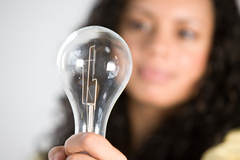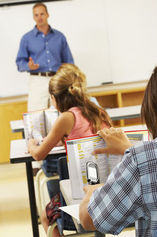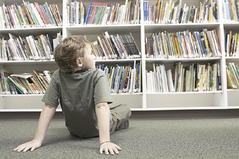NETS for Students
The ISTE standards for students can be found in the NETS*S document. NETS (National Education Technology Standards) have outlined specifics for what a student should know when leaving the K-12 educational system. This page will outline those and provide examples of classroom application which would reinforce these standards with students. The information came from the ISTE website and has been tailored to the students in the Canyons School District.
The major goal for students is to help them reach the highest levels of thinking and to prepare them to use the tools that will help them reach college or career readiness. Technology provides these opportunities to learn in engaging and efficient ways! |
Uses:
1. Provides a standard for teachers to build lessons/projects
2. Clear expectations for students to guide them through school experiences 3. Teachers have a guide to continue to develop to keep up with the pace of technology Documentation:
Click on the file below to read the official NETS*S document:
Links:
Last edited by: Katie Dewey 02/04/13
| ||||||
1. Creativity and Innovation

Students will demonstrate creative thinking, construct knowledge, and develop innovative products and processes using technology.
Students need to be able to work beyond their desks with pens and paper. They need the medium of technology to have access to necessary information resources, synthesize that information, and present that information in an organized manner. Many programs allow the students to do this. The Apple iWork and iLife Suites of programs can really help a student to put their knowledge into a great technology-based presentation that can be presented in class and published in other media as well. Prezi is a site where students can create amazing presentations.
- Opportunities to apply knowledge toward generating new ideas, products or processes.
- The creation of original projects individually and in groups.
- The utilization of models and simulations to explore complex systems and issues
- Opportunities to identify trends and forecast possibilities
Students need to be able to work beyond their desks with pens and paper. They need the medium of technology to have access to necessary information resources, synthesize that information, and present that information in an organized manner. Many programs allow the students to do this. The Apple iWork and iLife Suites of programs can really help a student to put their knowledge into a great technology-based presentation that can be presented in class and published in other media as well. Prezi is a site where students can create amazing presentations.
2. Communication and Collaboration

Students will use digital media and environments to communicate and work collaboratively, including at a distance, to support individual learning and contribute to the learning of others.
Technology expands the students' sphere of influence. Without purchasing plane tickets and making housing arrangements, students can interface with people on the other side of the world. Here is one story about a soldier in Afganistan who had a conversation with students in a classroom. Here is a Prezi presentation that provides some application for FaceTime in the classroom.
- Interaction, collaboration, and publication of work with peers, experts, or others employing a variety of digital environments and media
- Communication of information of ideas effectively to multiple audiences using a variety of media and formats
- Development of cultural awareness and global understanding through engaging with learners from other cultures
- Contribution to project teams to produce original works and/or to solve problems
Technology expands the students' sphere of influence. Without purchasing plane tickets and making housing arrangements, students can interface with people on the other side of the world. Here is one story about a soldier in Afganistan who had a conversation with students in a classroom. Here is a Prezi presentation that provides some application for FaceTime in the classroom.
3. Research and Information Fluency

Students will apply digital tools to gather, evaluate, and use information.
In order for a student to be able to utilize technology effectively in their learning, he/she will need to be able to distinguish credible information from less reliable information. To do this, they will need to be able to compare sources, understand how to determine whether a source is reputable or not, and be able to present perspectives and their merit. The Library of Congress offers some instruction on the use of primary sources in research. A reputable source for all Utah students is the Pioneer Library System. This provides encyclopedias, peer-reviewed journals, and more!
- Planning strategies to guide inquiry
- Locating, organizing, analyzing, evaluating, synthesizing, and ethically using information from a variety of sources and media
- Evaluation and selection of information sources and digital tools based on the appropriateness to specific tasks
- Processing data and report results
In order for a student to be able to utilize technology effectively in their learning, he/she will need to be able to distinguish credible information from less reliable information. To do this, they will need to be able to compare sources, understand how to determine whether a source is reputable or not, and be able to present perspectives and their merit. The Library of Congress offers some instruction on the use of primary sources in research. A reputable source for all Utah students is the Pioneer Library System. This provides encyclopedias, peer-reviewed journals, and more!
4. Critical Thinking, Problem Solving, and Decision Making

Students will use critical thinking skills to plan and conduct research, manage projects, solve problems, and make informed decisions using appropriate digital tools and resources.
Students can become aware of their world's problems through experiences with published media found online or otherwise. Students can involve themselves in causes in their neighborhood or far away with a click of the mouse. Social networking sites such as Facebook, Twitter, and Linkedin have provided students, teachers, and other professionals a way to collaborate and get involved as never before!
- Identification and definition of authentic problems and significant questions for investigation
- Planning and management of activities to develop a solution or complete a project
- Collection and analyzing of data to identify solutions and/or make informed decisions
- The use of multiple processes and diverse perspectives to explore alternative solutions
Students can become aware of their world's problems through experiences with published media found online or otherwise. Students can involve themselves in causes in their neighborhood or far away with a click of the mouse. Social networking sites such as Facebook, Twitter, and Linkedin have provided students, teachers, and other professionals a way to collaborate and get involved as never before!
5. Digital Citizenship

Students understand human, cultural, and societal issues related to technology and practice legal and ethical behavior.
This is an area that can seem slower to evolve than it should. With the wealth of information available it can seem a challenge to help students to be responsible with the things they publish and/or consume. They need to be able to distinguish between quality and questionable sources. Intellectual property is freely available online and can be used without permission if students aren't educated about online citation and etiquette. It is essential for educators, parents, and other stake-holders in the lives of students to offer clear guidance on how to always act with good digital citizenship. For information published by Canyons District on Digital Citizenship click here.
- Advocate and practice safe, legal, and responsible use of information and technology
- Exhibit a positive attitude toward using technology that supports collaboration, learning, and productivity
- Demonstrate personal responsibility for lifelong learning
- Exhibit leadership for digital citizenship
This is an area that can seem slower to evolve than it should. With the wealth of information available it can seem a challenge to help students to be responsible with the things they publish and/or consume. They need to be able to distinguish between quality and questionable sources. Intellectual property is freely available online and can be used without permission if students aren't educated about online citation and etiquette. It is essential for educators, parents, and other stake-holders in the lives of students to offer clear guidance on how to always act with good digital citizenship. For information published by Canyons District on Digital Citizenship click here.
6. Technology Operations and Concepts

Students demonstrate a sound understanding of technology concepts, systems, and operations.
Students of today must be good problem-solvers. Computer literacy is critical for the success in today's working economy. In order for students to be prepared, they will need to be comfortable with a keyboard, mouse, and other computer equipment. They will need to know how to share documents between devices and with others. The use of a USB flash drive or Dropbox can enable them to keep documents with them or in "the Cloud". They will need to be comfortable with computer operating systems. Students will need to understand how to use tablets to present/view/create documents and other presentations. Most importantly, they will need to know how to learn how to use programs and how to solve problems as they arise. Much of this understanding comes by doing! This is where the educator responsibility lies: we must provide opportunities for the student to have regular technological experiences in and out of the classroom. For information on the Apple Mac OS click here. For information on the PC operating system click here.
- Understand and use technology systems
- Select and use applications effectively and productively
- Troubleshoot systems and applications
- Transfer current knowledge to learning of new technologies
Students of today must be good problem-solvers. Computer literacy is critical for the success in today's working economy. In order for students to be prepared, they will need to be comfortable with a keyboard, mouse, and other computer equipment. They will need to know how to share documents between devices and with others. The use of a USB flash drive or Dropbox can enable them to keep documents with them or in "the Cloud". They will need to be comfortable with computer operating systems. Students will need to understand how to use tablets to present/view/create documents and other presentations. Most importantly, they will need to know how to learn how to use programs and how to solve problems as they arise. Much of this understanding comes by doing! This is where the educator responsibility lies: we must provide opportunities for the student to have regular technological experiences in and out of the classroom. For information on the Apple Mac OS click here. For information on the PC operating system click here.

